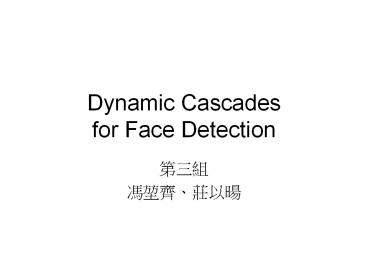Dynamic Cascades for Face Detection - PowerPoint PPT Presentation
1 / 22
Title:
Dynamic Cascades for Face Detection
Description:
Training rapid classifiers on data sets with large numbers of ... P.Viola andM. Jones. Rapid object detection using a boosted cascade of simple features. ... – PowerPoint PPT presentation
Number of Views:48
Avg rating:3.0/5.0
Title: Dynamic Cascades for Face Detection
1
Dynamic Cascades for Face Detection
- ???
- ???????
2
Outline
- Introduction
- Dynamic Cascade
- Boosting with a Bayesian Stump
- Experiments
- Conclusion
- Reference
3
Introduction
- Adaboost cascade
- First highly-accurate real-time face detector.
- Training rapid classifiers on data sets with
large numbers of negative samples. - Yeilds low false alarm rate.
- Once a positive sample is misclassified, it
cannot be corrected.
4
Dynamic Cascade
- Training face detector using data set with
massive numbers of positive and negative samples. - Using only a small subset of training data,
called dynamic working set, for boost training. - Updating the dynamic working set when its
distribution is less representative of the whole
training data.
5
Dynamic Cascade
- Rejection threshold
- Trade-offs between speed and detection rate.
- False negative rate vt
- k normalization factor.
- a free parameter to trade between detection
speed and accuracy.
6
Learning From Multiple Feature Sets
- Haar-like features.
- Gabor wavelet features.
- EOH (Edge Orientation Histogram) features.
7
Dynamic Cascade Learning
8
Dynamic Cascade Learning
9
Dynamic Cascade Learning
10
Boosting with a Bayesian Stump
- Extending the naive decision stump to a
single-node multi-way split decision tree method.
11
Bayesian Error
12
Bayesian Stump
13
Bayesian Stump
14
Experiments
- Positive set 531141 samples. (including shift,
scale, and rotation) - Validation set 40000 samples.
- Negative set 10 billion samples.
- Sample size 24 x 24
15
Experiments
16
The Importance of Using Large Training Data Sets
17
The Effects of Using Different Weak Classifiers
18
The Effects of Using Different Alpha Parameters
19
The Effects of Using Multiple Feature Sets
20
Performance Comparisons on Multiple Data Sets
21
Conclusion
- Introducing a novel algorithm called dynamic
cascade for robust face detection. - Contributions
- Using a dynamic working set for bootstrapping
positive samples. - New weak classifier called Bayesian stump.
- A novel strategy for learning from multiple
feature sets.
22
Reference
- S. C. Brubacker, M. D. Mullin, and J. M. Rehg.
Towards optimal training of cascade classifiers.
In Proc. of European Conference on Computer
Vision, 2006. - H. Luo. Optimization design of cascaded
classifiers. In Proc. of IEEE Conf. on Computer
Vision and Pattern Recognition, 2005. - P.Viola andM. Jones. Rapid object detection using
a boosted cascade of simple features. In Proc. of
IEEE Conf. on Computer Vision and Pattern
Recognition, volume 1, pages 511518, 2001.































